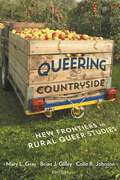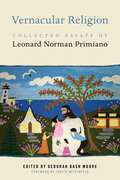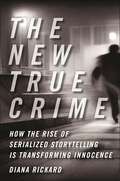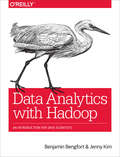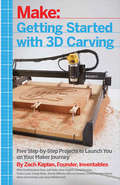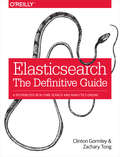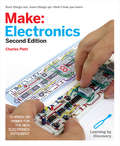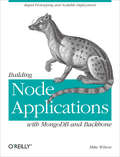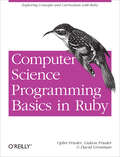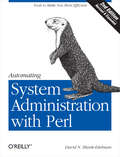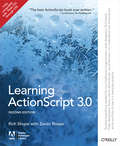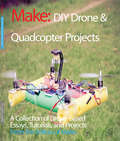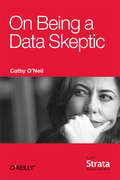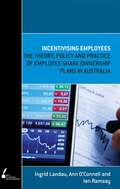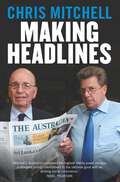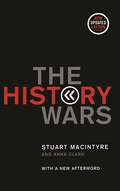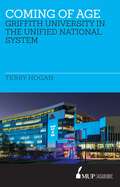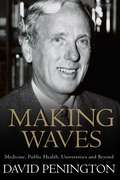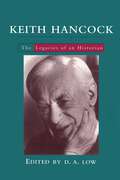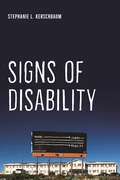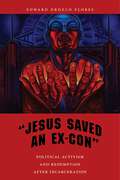- Table View
- List View
Queering the Countryside: New Frontiers in Rural Queer Studies (Intersections #11)
by Mary L. Gray Brian J. Gilley Colin R. JohnsonChoice Outstanding Academic Title of 2016Rural queer experience is often hidden or ignored, and presumed to be alienating, lacking, and incomplete without connections to a gay culture that exists in an urban elsewhere. Queering the Countryside offers the first comprehensive look at queer desires found in rural America from a genuinely multi-disciplinary perspective. This collection of original essays confronts the assumption that queer desires depend upon urban life for meaning.By considering rural queer life, the contributors challenge readers to explore queer experiences in ways that give greater context and texture to modern practices of identity formation. The book’s focus on understudied rural spaces throws into relief the overemphasis of urban locations and structures in the current political and theoretical work on queer sexualities and genders. Queering the Countryside highlights the need to rethink notions of “the closet” and “coming out” and the characterizations of non-urban sexualities and genders as “isolated” and in need of “outreach.” Contributors focus on a range of topics—some obvious, some delightfully unexpected—from the legacy of Matthew Shepard, to how heterosexuality is reproduced at the 4-H Club, to a look at sexual encounters at a truck stop, to a queer reading of TheWizard of Oz.A journey into an unexplored slice of life in rural America, Queering the Countryside offers a unique perspective on queer experience in the modern United States and Canada.
Vernacular Religion: Collected Essays of Leonard Norman Primiano (North American Religions #17)
by Deborah Dash MooreFinalist, Award for Excellence in the Study of Religion, Analytical-Descriptive Studies, given by the American Academy of ReligionA comprehensive collection of the pioneering work of Leonard Norman Primiano, one of the preeminent scholars in religious studiesIn 1995, Leonard Norman Primiano introduced the idea of “vernacular religion.” He coined this term to overcome the denigration implied in the concept of “folk religion” or “popular religion,” which was juxtaposed to “elite religion.” This two-tiered model suggested that religion existed somewhere in a pure form and that the folk version transforms it. Instead, Primiano urged scholars to adopt an inductive approach to the study of religion and to pay attention to experiential aspects of belief systems, ultimately redressing a heritage of scholarly misinterpretation.Here for the first time, Leonard Norman Primiano’s pioneering works have been collected into one volume, providing a foundational look at one of the preeminent scholars of twentieth-century religious studies. Vernacular Religion makes visible the dimensions of vernacular religion in North America, exemplifying the richness of its ability to explain key facets of American society, including especially thorny issues around race and sexuality. The volume also demonstrates a method of abiding engagement, the creation of ongoing relationships with those who are studied, and how the relationship between scholars and the communities they study inform an ethics of critical commitment—what Primiano calls an “ethnography of collaboration and reciprocity.”This posthumous collection, edited by Deborah Dash Moore, brings together key studies in vernacular religion that explore its expression among such varied groups as Catholics, LGBTQ Christians, and the followers of Father Divine. Vernacular Religion models empathetic ethnographic engagement that embraces American religion in all its rich diversity, illuminating Primiano’s enduring legacy.
The New True Crime: How the Rise of Serialized Storytelling Is Transforming Innocence (Alternative Criminology)
by Diana RickardHow serialized crime shows became an American obsessionTV shows and podcasts like Making a Murderer, Serial, and Atlanta Monster have taken the cultural zeitgeist by storm, and contributed to the release of wrongly imprisoned people—such as Adnan Syed. The popularity of these long-form true crime docuseries has sparked greater attention to issues of inequality, power, social class, and structural racism. More and more, the American public is asking, Who is and is not deserving of punishment, and who is and is not protected by the law? In The New True Crime, Diana Rickard argues that these new true crime series deserve our attention for what they reveal about our societal understanding of crime and punishment, and for the new light they shine on the inequalities of the criminal justice system. Questioning the finality of verdicts, framing facts as in the eye of the beholder—these new series unmoor our faith in what is knowable, even as, Rickard critically notes, they often blur the lines between “fact” and “fiction.”With a focus on some of the most popular true crime podcasts and streaming series of the last decade, Rickard provides an in-depth analysis of the ways in which this new media—which allows for binge-listening or watching—makes crime into a public spectacle and conveys ideological messages about punishment to its audience. Entertainment values have always been entwined with crime news reporting. Newsworthy stories, Rickard reminds us, need to involve sex, violence, or a famous person, and contain events that can be framed in terms of individualism and conservative ideologies about crime. Even as these old tropes of innocent victims and deviant bad guys still dominate these docuseries, Rickard also unpacks how the new true crime has been influenced by the innocence movement, a diverse group of organizers and activists, be they journalists, lawyers, formerly incarcerated people, or family members, who now have a place in mainstream consciousness as DNA evidence exonerates the wrongly convicted.The New True Crime questions the knowability of truth and probes our anxieties about the “real” nature of true crime media. For fans of true crime shows and anyone concerned about justice in America, this book will prove to be essential reading.
Data Analytics with Hadoop: An Introduction for Data Scientists
by Jenny Kim Benjamin BengfortReady to use statistical and machine-learning techniques across large data sets? This practical guide shows you why the Hadoop ecosystem is perfect for the job. Instead of deployment, operations, or software development usually associated with distributed computing, you’ll focus on particular analyses you can build, the data warehousing techniques that Hadoop provides, and higher order data workflows this framework can produce.Data scientists and analysts will learn how to perform a wide range of techniques, from writing MapReduce and Spark applications with Python to using advanced modeling and data management with Spark MLlib, Hive, and HBase. You’ll also learn about the analytical processes and data systems available to build and empower data products that can handle—and actually require—huge amounts of data.Understand core concepts behind Hadoop and cluster computingUse design patterns and parallel analytical algorithms to create distributed data analysis jobsLearn about data management, mining, and warehousing in a distributed context using Apache Hive and HBaseUse Sqoop and Apache Flume to ingest data from relational databasesProgram complex Hadoop and Spark applications with Apache Pig and Spark DataFramesPerform machine learning techniques such as classification, clustering, and collaborative filtering with Spark’s MLlib
Getting Started with 3D Carving: Five Step-by-Step Projects to Launch You on Your Maker Journey
by Zach Kaplan3D printing has been the hot topic in the maker world for years now, but there's another type of desktop manufacturing that's become the go-to choice for anyone who needs durable results fast. Instead of slowly depositing layers of plastic, a 3D carver starts with a solid block of material and carves it away using a rotating metal bit. It's faster than 3D printing, offers a wider choice of materials, and creates durable, permanent parts that look great. This book covers the basics of designing and making things with a 3D carver, and gives you several projects you can build yourself including a guitar, clock, earrings, and even a skateboard.
Elasticsearch: A Distributed Real-Time Search and Analytics Engine
by Clinton Gormley Zachary TongWhether you need full-text search or real-time analytics of structured data—or both—the Elasticsearch distributed search engine is an ideal way to put your data to work. This practical guide not only shows you how to search, analyze, and explore data with Elasticsearch, but also helps you deal with the complexities of human language, geolocation, and relationships.If you’re a newcomer to both search and distributed systems, you’ll quickly learn how to integrate Elasticsearch into your application. More experienced users will pick up lots of advanced techniques. Throughout the book, you’ll follow a problem-based approach to learn why, when, and how to use Elasticsearch features.Understand how Elasticsearch interprets data in your documentsIndex and query your data to take advantage of search concepts such as relevance and word proximityHandle human language through the effective use of analyzers and queriesSummarize and group data to show overall trends, with aggregations and analyticsUse geo-points and geo-shapes—Elasticsearch’s approaches to geolocationModel your data to take advantage of Elasticsearch’s horizontal scalabilityLearn how to configure and monitor your cluster in production
Make: Learning Through Discovery (Make Ser.)
by Charles Platt"This is teaching at its best!"--Hans Camenzind, inventor of the 555 timer (the world's most successful integrated circuit), and author of Much Ado About Almost Nothing: Man's Encounter with the Electron (Booklocker.com)"A fabulous book: well written, well paced, fun, and informative. I also love the sense of humor. It's very good at disarming the fear. And it's gorgeous. I'll be recommending this book highly."--Tom Igoe, author of Physical Computing and Making Things TalkA "magnificent and rewarding book. ... Every step of this structured instruction is expertly illustrated with photos and crisp diagrams. . . . This really is the best way to learn."--Kevin Kelly, in Cool ToolsThe first edition of Make: Electronics established a new benchmark for introductory texts. This second edition enhances that learning experience.Here you will find unique, photographically precise diagrams of breadboarded components, to help you build circuits with speed and precision. A new shopping guide and a simplified range of components, will minimize your investment in parts for the projects. A completely new section on the Arduino shows you how to write properly structured programs instead of just downloading other people's code. Projects have been reworked to provide additional features, and the book has been restructured to offer a step-by-step learning process that is as clear and visually pleasing on handheld devices as it is on paper. Full color is used throughout.As before, Make: Electronics begins with the basics. You'll see for yourself how components work--and what happens when they don't. You'll short out a battery and overheat an LED. You'll also open up a potentiometer and a relay to see what's inside. No other book gives you such an opportunity to learn from real-life experiences.Ultimately, you will build gadgets that have lasting value, and you'll have a complete understanding of how they work. From capacitors to transistors to microcontrollers--it's all here.Hans Camenzind, inventor of the 555 Timer (the world's most successful integrated circuit chip), said that "This is teaching at its best!" when he reviewed the first edition. Now the second edition offers even more!
Building Node Applications with MongoDB and Backbone: Rapid Prototyping and Scalable Deployment
by Mike WilsonBuild an application from backend to browser with Node.js, and kick open the doors to real-time event programming. With this hands-on book, you’ll learn how to create a social network application similar to LinkedIn and Facebook, but with a real-time twist. And you’ll build it with just one programming language: JavaScript.If you’re an experienced web developer unfamiliar with JavaScript, the book’s first section introduces you to the project’s core technologies: Node.js, Backbone.js, and the MongoDB data store. You’ll then launch into the project—a highly responsive, highly scalable application—guided by clear explanations and lots of code examples.Learn about key modules in Node.js for building real-time appsUse the Backbone.js framework to write clean browser code, and maintain better data integration with MongoDBStructure project files as a foundation for code that will arrive laterCreate user accounts and learn how to secure the dataUse Backbone.js templates to build the application’s UIs, and integrate access control with Node.jsDevelop a contact list to help users link to and track other accountsUse Socket.io to create real-time chat functionalityExtend your UIs to give users up-to-the-minute information
Computer Science Programming Basics in Ruby: Exploring Concepts and Curriculum with Ruby
by David Grossman Gideon Frieder Ophir FriederIf you know basic high-school math, you can quickly learn and apply the core concepts of computer science with this concise, hands-on book. Led by a team of experts, you’ll quickly understand the difference between computer science and computer programming, and you’ll learn how algorithms help you solve computing problems.Each chapter builds on material introduced earlier in the book, so you can master one core building block before moving on to the next. You’ll explore fundamental topics such as loops, arrays, objects, and classes, using the easy-to-learn Ruby programming language. Then you’ll put everything together in the last chapter by programming a simple game of tic-tac-toe.Learn how to write algorithms to solve real-world problemsUnderstand the basics of computer architectureExamine the basic tools of a programming languageExplore sequential, conditional, and loop programming structuresUnderstand how the array data structure organizes storageUse searching techniques and comparison-based sorting algorithmsLearn about objects, including how to build your ownDiscover how objects can be created from other objectsManipulate files and use their data in your software
Automating System Administration with Perl: Tools to Make You More Efficient
by David N. Blank-EdelmanIf you do systems administration work of any kind, you have to deal with the growing complexity of your environment and increasing demands on your time. Automating System Administration with Perl, Second Edition, not only offers you the right tools for your job, but also suggests the best way to approach specific problems and to securely automate recurring tasks.Updated and expanded to cover the latest operating systems, technologies, and Perl modules, this edition of the "Otter Book" will help you:Manage user accountsMonitor filesystems and processesWork with configuration files in important formats such as XML and YAMLAdminister databases, including MySQL, MS-SQL, and Oracle with DBIWork with directory services like LDAP and Active DirectoryScript email protocols and spam controlEffectively create, handle, and analyze log filesAdminister network name and configuration services, including NIS, DNS and DHCPMaintain, monitor, and map network services, using technologies and tools such as SNMP, nmap, libpcap, GraphViz and RRDtoolImprove filesystem, process, and network securityThis edition includes additional appendixes to get you up to speed on technologies such as XML/XPath, LDAP, SNMP, and SQL. With this book in hand and Perl in your toolbox, you can do more with less -- fewer resources, less effort, and far less hassle.
Learning ActionScript 3.0: A Beginner's Guide (Learning Ser.)
by Rich Shupe Zevan RosserIf you're new to ActionScript 3.0, or want to enhance your skill set, this bestselling book is the ideal guide. Designers, developers, and programmers alike will find Learning ActionScript 3.0 invaluable for navigating ActionScript 3.0's learning curve. You'll learn the language by getting a clear look at essential topics such as logic, event handling, displaying content, classes, and much more.Updated for Flash Professional CS5, this revised and expanded edition delivers hands-on exercises and full-color code samples to help you increase your abilities as you progress through the book. Topics are introduced with basic syntax and class-based examples, so you can set your own pace for learning object-oriented programming.Harness the power and performance of ActionScript 3.0Control sound and video, including new access to microphone dataCreate art with code by drawing vectors and pixels at runtimeManipulate text with unprecedented typographic controlAnimate graphics, create particle systems, and apply simple physicsAvoid common coding mistakes and reuse code for improved productivityLoad SWF, image, text, HTML, CSS, and XML file formats, and moreAuthors Rich Shupe and Zevan Rosser draw on their experience as Flash developers and instructors to give you a solid ActionScript foundation, revealing ways you can use code for practical, everyday projects.
DIY Drone and Quadcopter Projects: A Collection of Drone-Based Essays, Tutorials, and Projects
by The Editors of Make:Drones, quadcopters, Uncrewed Aerial Vehicles (UAVs): whatever they're called, remotely-controlled aircraft have changed the way we see the world, the way we manage crops, the way we sell real estate, and the way we make war. This book contains tutorials about how to understand what drones can do, and projects about how to make your own flying craft, from some of the earliest practitioners in the field.
On Being a Data Skeptic
by Cathy O'Neil"Data is here, it's growing, and it's powerful." Author Cathy O'Neil argues that the right approach to data is skeptical, not cynical––it understands that, while powerful, data science tools often fail. Data is nuanced, and "a really excellent skeptic puts the term 'science' into 'data science.'" The big data revolution shouldn't be dismissed as hype, but current data science tools and models shouldn't be hailed as the end-all-be-all, either.
Incentivising Employees: The theory, policy and practice of employee share ownership plans in Australia
by Ann O'Connell Ian Ramsay Ingrid LandauEmployee share ownership has the potential to generate a culture of enterprise and innovation, and build national wealth and savings. This book is the culmination of a multi-year research project funded by the Australian Research Council and represents the first detailed discussion of the theory, policy and practice of employee share ownership plans (ESOPs) in Australia. The topics examined in the book are key legal and policy issues relevant to ESOPs, the current incidence and forms of ESOPs in Australia, the corporate law and taxation law frameworks, why employers implement ESOPs and why employees participate in them, international comparisons, and recommendations for reform.
Making Headlines
by Chris MitchellAs editor-in-chief of The Australian, Chris Mitchell ran the largest stable of journalists with the largest editorial budget in the country for more than twelve years. This entertaining and deeply revealing book offers readers riveting insights into the quirks and foibles of some of the most powerful politicians and media executives this country has produced. A controversial figure throughout his quarter of a century as a daily editor, Chris Mitchell still maintains close regular contact with past prime ministers, editors and media CEOs. Making Headlines highlights the judgements and thinking that govern daily newspaper journalism at the highest level and the battles fought to publish tough stories about the rich and the powerful, the disenfranchised and the powerless. Making Headlines is compulsory reading for citizens who care, the political class inside the beltway and beyond, and wannabe journalists in search of a job.
History Wars
by Stuart Macintyre Anna ClarkThe nation's history has probably never been more politicised than it is today. Politicians, journalists, columnists, academics and Australians from all walks of life argue passionately — and often, ideologically — about the significance of the national story: the cherished ideal of the 'fair go', the much contested facts of Indigenous dispossession, the Anzac legend, and the nation's strategic alliance with the United States. Historians have become both combatants and casualties in this war of words. In The History Wars, Stuart Macintyre and Anna Clark explore how this intense public debate has polarised the nation and paralysed history departments. This edition includes a new afterword by Stuart Macintyre which recounts, with rueful irony, the outbreak of controversy that followed the book's original publication, and the further light it shed on the uses and abuses of Australian history.
Backyard Insects Updated Edition
by Paul Horne Denis CrawfordLove them or loathe them, we can't avoid insects.From aphids to flies, ladybirds to wasps, insects of all shapes and sizes share our homes and gardens. Now in updated edition, the bestselling Backyard Insects explores the secrets and habits of more than one hundred little critters that are common to backyard Australia. Crawling with full-colour, larger-than-life photographs for easy identification, Backyard Insects is an indispensable guide for nature lovers, gardeners and kids of all ages.
Coming of Age: Griffith University in the Unified National System
by Terry HoganIn December 1987 John Dawkins, the Australian Government Minister for Employment, Education and Training released a Green Paper that foreshadowed major changes in the tertiary education sector through the formation of a Unified National System. This was 16 years after the establishment of Griffith University and only 12 years since the admission of Griffith's first undergraduate students. Dawkins' ideas presented Griffith University with a dilemma: whether to continue being different from other Australian universities-a boutique institution committed to 'the Griffith way' in pedagogy with a relatively small student enrolment and academic profile-or to become more like its academic peers and embrace growth and diversity. In only three years Griffith amalgamated with other academic institutions to become a multi-campus university, while still retaining some of its founding characteristics. Griffith emerged from the changes as a large and complex institution, different in ways that its founders could not have imagined. Coming of Age traces the impact on Griffith University of the creation of the Unified National system.
Making Waves: Medicine, Public Health, Universities and Beyond
by David PeningtonThroughout his academic and medical careers, David Penington has been an agent of change. In his fascinating memoirs, one of Australia's leading public health experts and the former Vice Chancellor of the University of Melbourne reveals his ethos, drives and the highs and lows of a life built on making waves. Appointed at St Vincent's Hospital in Melbourne, he fostered new medical research specialty areas in haematology, medical oncology, endocrinology, gastroenterology and later neurology, and renal disease--a strategic development for a public hospital in the early 1970s. At the University of Melbourne, he was Professor and then Dean of the Faculty of Medicine, before becoming Vice Chancellor in 1988. During his tenure, he strongly resisted major and damaging government intrusion into the operations of universities, all the while reforming the education, research and management practices at the University of Melbourne. He has been at the forefront of national public health policy for more than twenty years, including four years chairing the National AIDS Task Force for the Hawke government. In 1984 he was Chair of the National Committee of Inquiry into a dispute between the government and the medical profession over public hospitals, which was key to the implementation of the Medicare system. He has also led two inquiries into illicit drug policies. Making Waves details a tireless leader who at every stage of his working life has never shunned public controversy in a bid to improve the lives of all Australians.
Whiteley on Trial
by Gabriella CoslovichIt was a cause c�l�bre: the biggest case of alleged art fraud to come before the Australian criminal justice system, a $4.5 million sting drawing in one of the country's most gifted and ultimately tragic artists, Brett Whiteley, a heroin addict who died alone in 1992.It started with suspicions raised about artworks being produced in the style of Whiteley in a Melbourne art restorer's studio. Secret photographs were taken as the paintings took form.A jury finds two men guilty of faking Whiteleys, but a year later the appeal bench sensationally acquits them. The paintings are returned to their owners, leaving the legitimacy of the artworks in limbo. Whiteley on Trial investigates this remarkable case and exposes the avarice of the art world, the disdain for connoisseurship and the fragility of authenticity.
Keith Hancock: The Legacies of an Historian
by D.A. LowSir Keith Hancock KBE (1898-1984) was the most distinguished scholar in the humanities and social sciences to have been born and to have worked in Australia. He was a graduate of the University of Melbourne, a Rhodes Scholar and the first Australian Fellow of All Souls College, Oxford. He successively held History chairs at the universities of Adelaide, Birmingham, Oxford and London and at the Australian National University. Aged 32 he published his Australia (London, 1930), still the single most striking commentary on this country, many of whose aphorisms have percolated through into numerous other writings. Aged 74 he published his last major work, Discovering Monaro: A Study of Man's Impact on the Environment (Cambridge, 1972), which was arguably the primary fillip to the study of Australian environmental history to this day. The main chapters of this book discuss, largely in sequence, the major books that he wrote, the fields with which he dealt, and the directions these have taken since he did so. They revisit an extraordinary series of creative achievements while providing an introduction to the work of an exceptional Australian scholar. The book will be important for anyone interested in the Humanities in Australia, and particularly for those concerned with Australian historiography. There are indications that imaginative teachers of History Honours students are already 'going back' to Hancock's writing and finding students responding positively to it.
Kabbalah and the Founding of America: The Early Influence of Jewish Thought in the New World
by Brian OgrenExplores the influence of Kabbalah in shaping America’s religious identityIn 1688, a leading Quaker thinker and activist in what is now New Jersey penned a letter to one of his closest disciples concerning Kabbalah, or what he called the mystical theology of the Jews. Around that same time, one of the leading Puritan ministers developed a messianic theology based in part on the mystical conversion of the Jews. This led to the actual conversion of a Jew in Boston a few decades later, an event that directly produced the first kabbalistic book conceived of and published in America. That book was read by an eventual president of Yale College, who went on to engage in a deep study of Kabbalah that would prod him to involve the likes of Benjamin Franklin, and to give a public oration at Yale in 1781 calling for an infusion of Kabbalah and Jewish thought into the Protestant colleges of America.Kabbalah and the Founding of America traces the influence of Kabbalah on early Christian Americans. It offers a new picture of Jewish-Christian intellectual exchange in pre-Revolutionary America, and illuminates how Kabbalah helped to shape early American religious sensibilities. The volume demonstrates that key figures, including the well-known Puritan ministers Cotton Mather and Increase Mather and Yale University President Ezra Stiles, developed theological ideas that were deeply influenced by Kabbalah. Some of them set out to create a more universal Kabbalah, developing their ideas during a crucial time of national myth building, laying down precedents for developing notions of American exceptionalism. This book illustrates how, through fascinating and often surprising events, this unlikely inter-religious influence helped shape the United States and American identity.
Jews Across the Americas: A Sourcebook, 1492–Present (Goldstein-Goren Series in American Jewish History)
by Adriana M. Brodsky and Laura Arnold LeibmanAn overview of the history of American Jewry using primary sources from Latin America, theCaribbean, Canada, and the United StatesJews Across the Americas is a groundbreaking sourcebook capturing the historical diversity and culturalbreadth of American Jews across Latin America, the Caribbean, Canada, and the United States. Featuringprimary documents as well as scholarly interpretations, Jews Across the Americas builds upon newdevelopments in Jewish Studies, engaging with transnationalism, race, sexuality, and gender, andhighlighting the lived experiences of those often left out of Jewish history.Jews Across the Americas features an impressively broad and far-reaching range of historical sources,including artifacts and objects that have not previously been featured as integral to Jewish history in theWestern hemisphere. Entries teach readers how to understand everything from wills andadvertisements to sermons, and how to interpret photographs, domestic architecture, and comics.Whether it’s a recipe from Brazil that blends Moroccan and Amazonian foodways, or a text about thefirst non-binary Jew to cross the Atlantic in the eighteenth century, each entry broadens ourunderstanding of Jewish American history.
Signs of Disability (Crip #4)
by Stephanie L. KerschbaumHow can we learn to notice the signs of disability?We see indications of disability everywhere: yellow diamond-shaped “deaf person in area” road signs, the telltale shapes of hearing aids, or white-tipped canes sweeping across footpaths. But even though the signs are ubiquitous, Stephanie L. Kerschbaum argues that disability may still not be perceived due to a process she terms “dis-attention.”To tell better stories of disability, this multidisciplinary work turns to rhetoric, communications, sociology, and phenomenology to understand the processes by which the material world becomes sensory input that then passes through perceptual apparatuses to materialize phenomena—including disability. By adding perception to the understanding of disability’s materialization, Kerschbaum significantly expands our understanding of disability, accounting for its fluctuations and transformations in the semiotics of everyday life.Drawing on a set of thirty-three research interviews focused on disabled faculty members’ experiences with disability disclosure, as well as written narratives by disabled people, this book argues for the materiality of narrative, suggesting narratives as a means by which people enact boundaries around phenomena and determine their properties. Signs of Disability offers strategies and practices for challenging problematic and pervasive forms of “dis-attention” and proposes a new theoretical model for understanding disability in social, rhetorical, and material settings.
"Jesus Saved an Ex-Con": Political Activism and Redemption after Incarceration (Religion and Social Transformation #9)
by Edward Orozco FloresAn examination of the efforts of faith-based organizations to expand the rights of the formerly incarcerated The use of religion to rehabilitate and redeem formerly incarcerated individuals has been a cultural touchstone of the modern era. Yet religious outreach to those with criminal records has typically been associated with an emphasis on private spirituality, with efforts focused on repentance, conversion, and restorative justice. This book sheds light on how faith-based organizations utilize the public arena, mobilizing to expand the social and political rights of former inmates. In “Jesus Saved an Ex-Con,” Edward Orozco Flores profiles Community Renewal Society and LA Voice, two faith-based organizations which have actively waged community organizing campaigns to expand the rights of people with records. He illuminates how these groups help the formerly incarcerated re-enter broader communities through the expansion of citizenship rights and participation in civic engagement. Most work on prisoner reentry has focused on how the behavior of those with records may be changed through interventions, rather than considering how those with records may change the society that receives them. Flores explores how the formerly incarcerated use redemption scripts to participate in civic engagement, to remove the felony conviction question from employment applications and to restrict the use of criminal background checks in housing and employment. He shows that people with records can redeem themselves while also challenging and changing the way society receives them.
